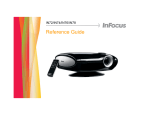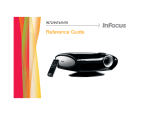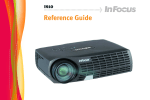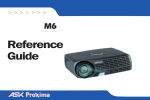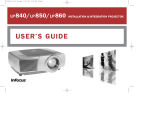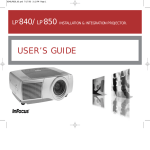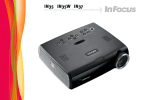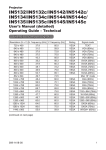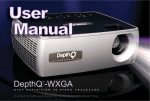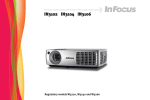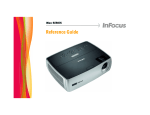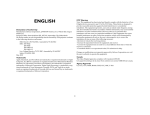Download User Manual - Projector Central
Transcript
K1 UG cover.pdf 8/2/2007 10:37:55 AM IN82 IN82 C IN82 User’s Guide M Y CM MY CY www.infocus.com/support CMY K 010-0629-01 *010-0629-01* User’s Guide Mode d’emploi Benutzeranleitung Manual de Uso Guidaall'uso Gebruikershandleiding Guia do usuário Användarhandbok 用户指南 K1 RG.fm Page 1 Thursday, September 27, 2007 10:24 AM Declaration of Conformity FCC Warning Manufacturer: InFocus Corporation, 27500 SW Parkway Ave. Wilsonville, Oregon 97070 USA European Office: Louis Armstrongweg 110, 1311 RL Almere, The Netherlands We declare under our sole responsibility that this projector conform to the following directives and norms: Note: This equipment has been tested and found to comply with the limits for a Class B digital device, pursuant to part 15 of the FCC Rules. These limits are designed to provide reasonable protection against harmful interference in a residential installation. This equipment generates, uses and can radiate radio frequency energy and, if not installed and used in accordance with the instructions, may cause harmful interference to radio communications. However, there is no guarantee that interference will not occur in a particular installation. If this equipment does cause harmful interference to radio or television reception, which can be determined by turning the equipment off and on, the user is encouraged to try to correct the interference by one or more of the following measures: --Reorient or relocate the receiving antenna. --Increase the separation between the equipment and receiver. --Connect the equipment into an outlet on a circuit different from that to which the receiver is connected. --Consult the dealer or an experienced radio/TV technician for help. EMC Directive 89/336/EEC, Amended by 93/68/EEC EMC: EN 55022 EN 55024 EN 61000-3-2 EN 61000-3-3 Low Voltage Directive 73/23/EEC, Amended by 93/68/EEC Safety: IEC 60950-1: 1st Edition July, 2007 Trademarks Changes or modifications not expressly approved by InFocus Corporation may void authority to operate the equipment. Adobe and Acrobat are trademarks or registered trademarks of Adobe Systems Incorporated. Digital Light Processing and BrilliantColor are trademarks or registered trademarks of Texas Instruments. ISF is a trademark or registered trademark of Imaging Science Foundation, Inc. Deep Color s a trademark or registered trademark of Pixelworks and DNX are trademarks or registered trademarks of Pixelworks Inc. HDMI, the HDMI logo and High-Definition Multimedia Interface are trademarks or registered trademarks of HDMI Canada This Class B digital apparatus complies with Canadian ICES-003. Cet appareil numérique de la classe B est conforme à la norme NMB-003 du Canada. Agency Approvals Licensing LLC. InFocus, In Focus, and INFOCUS (stylized), ASK and Proxima are either registered trademarks or trademarks of InFocus Corporation in the United States and other countries. UL, cUL, TUV, GOST Other specific Country Approvals may apply. Please see product certification label. This document applies to models IN82 and P820. InFocus reserves the right to alter product offerings and specifications at any time without notice. 1 K1 RG.fm Page 2 Thursday, September 27, 2007 10:24 AM Important Operating Considerations for Safety Table of Contents Introduction 3 • Positioning the projector Choosing the aspect ratio 5 6 Place the projector in a horizontal position no greater than 15 degrees off axis. • Connecting a video device Video connectors Digital connections HDMI 1.3 connection DVI connection Component (RCA) connection S-video connection Composite (RCA) video connection 7 7 7 8 8 8 8 8 Locate the projector in a well-ventilated area without any obstructions to intake or exhaust vents. Do not place the projector on a tablecloth or other soft covering that may block the vents. • Locate the projector at least 4' (1.2 m) away from any heating or cooling vents. • Use only InFocus-approved ceiling mounts. • Use only the power cord provided. A surge-protected power strip is recommended. • Refer to this guide for proper startup and shutdown procedures. Computer connections RS-232 connections 8 8 • Hg – Lamp contains mercury. Manage in accordance with local disposal laws. See www.lamprecycle.org. • Displaying an image Adjusting the image Shutting down the projector 9 9 11 In the unlikely event of a lamp rupture, particles may exit through the projector side vents. When the projector is turned on, keep people, food, and drinks out of the "keep out" area under and around the projector, as indicated by the "X" areas below. Troubleshooting your setup 11 Using the remote control Optimizing video images Customizing the projector 17 18 18 Using the menus Picture menu Settings menu 19 20 24 Maintenance Replacing the projection lamp 27 27 Appendix Remote control discrete codes Projector dimensions for ceiling mount installations RS-232 terminal Product Interface specifications 29 29 29 31 2 / 5’ m 1.5 3’ / 1 m 2’ 8’ / 2 .4 m /0 .6 m Follow these instructions to help ensure image quality and lamp life over the life of the projector. Failure to follow these instructions may affect the warranty. For complete details of the warranty, see the Warranty booklet. K1 RG.fm Page 3 Thursday, September 27, 2007 10:24 AM Introduction Your new InFocus projector is specifically designed for home theater applications. It sets a high standard using the latest DLP™ technology and new DNX™ video processing from Pixelworks™. The projector has 1920x1080 resolution (1080p). Whether you are watching movies or High Definition broadcasts or playing the latest video game, you will enjoy amazing image quality. remote control receiver (IR) Product specifications To read the latest specifications, be sure to visit our website at www.infocus.com as specifications are subject to change. status indicator panel Online Registration Register your projector on our website at www.infocus.com/register to activate your warranty and receive product updates, announcements, and registration incentives. Included items • power cord • HDMI™ cable • M1-to-HDMI adapter • remote control • swivel base (for tabletop use) • polishing cloth • cable cover (attached to projector) swivel base connector panel remote control receiver (IR) Optional accessories can be found on our website at www.infocus.com or at your retailer or dealer. focus ring zoom ring 3 K1 RG.fm Page 4 Thursday, September 27, 2007 10:24 AM Connector Panel composite RCA Remove the cable cover, if attached, to access the connector panel. Replace the cover after the projector is installed, if desired. S-video The projector provides the following connection options: • M1-DA/DVI (Digital Visual Interface) • HDMI™ (High Definition Multimedia Interface) • Component (RCA) • S-video • Composite video (RCA) See “Video connectors” on page 7 for details. The projector also provides the following connectors: • RS-232 for serial control • Two 12 volt DC outputs (see below) • IR input for connection to Niles/Xantech compatible IR repeater systems HDMI +12v 12 volt DC outputs M1-DA/ DVI component RCA IR input RS-232 12 volt DC output ground 3.5mm plug The 3.5mm mini-jack triggers provide a 12 volt, 0.25 amp DC output. They provide a constant output while the projector is on. They are typically used for screen control. For example, if you connect your projection screen to the vertical screen trigger with the cable that came with your screen, when you turn on the projector the screen will move down; when you turn the projector off, the screen will return to the storage position. The horizontal screen trigger output can be used to control curtains or an adjustable aspect ratio screen. to, for example, screen relay (see screen manufacturer for details) 4 K1 RG.fm Page 5 Thursday, September 27, 2007 10:24 AM Positioning the projector Table 1: Range of distance to the screen for a given screen size To determine where to position the projector, consider the size and shape of your screen, the location of your power outlets, and the distance between the projector and the rest of your equipment. Here are some guidelines: • Position the projector on a flat surface at a right angle to the screen. The projector must be at least 4.9 feet (1.5m) from the projection screen. • For safety reasons, position the projector within 10 feet (3m) of your power source (running extension cables may introduce a trip hazard). To ensure adequate cable access, do not place the projector within 6 inches (.15m) of a wall or other object. • If you are installing the projector on the ceiling, refer to the installation guide that comes with the Ceiling Mount Kit for more information. To turn the image upside down, see “Ceiling” on page 24. We recommend using an InFocus authorized ceiling mount. • Position the projector the desired distance from the screen. The distance from the lens of the projector to the screen, the zoom setting, and the video format determine the size of the projected image. • The image offset is 136%. This means that if you have an image 10’ high, the bottom of the image will be 3.6’ above the center of the lens. 10 ft high image Distance to screen Diagonal Screen Size (inches/m) Horizontal Screen Size (inches/m) Maximum distance (feet/m) Minimum Distance (feet/m) 60/1.5 80/2 92/2.3 150/3.8 52.6/1.3 69.8/1.8 80.2/2 130.9/3.3 9.7/2.96 12.9/3.94 14.8/4.52 24.2/7.38 8.1/2.47 10.8/3.28 12.4/3.77 20.2/6.15 NOTE: Visit the Service section of our website at www.infocus.com/calculator for an interactive image size calculator. Projection angle in 16:9 mode bottom of image 3.6 ft above center of lens lens center 5 K1 RG.fm Page 6 Thursday, September 27, 2007 10:24 AM Choosing the aspect ratio 16:9 image 16:9 image input 16:9 aspect ratio 9 9 16 16 4:3 image input 4:3 aspect ratio 4:3 image on 16:9 screen 3 9 16 4 NOTE: If you purchase an optional anamorphic lens, select the Letterbox option to achieve the 2.35:1 aspect ratio. black bars What you plan to project will also help you choose between 4:3 and 16:9. For example, most TV shows are 4:3, while most movies are 16:9. If you have a 16:9 screen, then you should select an aspect ratio of 16:9 for anamorphic movies and HDTV, and Native for 4:3 content. If you have a 4:3 screen you should still use 16:9 for anamorphic movies or HDTV, but you also have the option of using 4:3, Native, or Natural Wide for 4:3 content. Keep in mind that anamorphic movies only appear correctly if the DVD player is set to output to a 16:9 television. Natural Wide stretches a 4:3 image to fill the entire 16:9 screen. The center two-thirds of the image is unchanged; the edges of the image are stretched. black bars Aspect ratio is the ratio of the image width to image height. HDTV and most DVDs are 16:9, which is the default for this projector. When in 4:3 mode the projector places black bars on both sides of the image. Native mode centers the image and turns off the internal scaler so that any resolution larger than the native projector resolution is cropped on the edges. Letterbox expands the image to fill the screen. letterbox image input 16:9 image fills 16:9 screen black bars letterbox aspect ratio 9 3 black bars 4 16 4:3 image input natural wide aspect ratio 3 9 4 6 4:3 image fills 16:9 screen 16 K1 RG.fm Page 7 Thursday, September 27, 2007 10:24 AM Connecting a video device composite RCA You can connect video devices such as HDTV receivers, HD-DVD players, VCRs, camcorders, digital cameras, video game consoles, and TV tuners to the projector. Connect the audio from your video device to your stereo system to get sound. S-video You can connect the projector to most video devices that can output video. You cannot directly connect the coaxial cable that enters your house from a cable or satellite company, the signal must pass through a tuner first. Examples of tuners are digital cable boxes, VCRs, digital video recorders, and satellite TV boxes. Basically, any device that can change channels is considered a tuner. Video connectors HDMI The first step for connecting video is determining what type of output connectors your video device has. If there is more than one output, select the one with the highest quality. The best quality ranking, with 1 being the highest, is: M1-DA/ DVI component RCA IR input RS-232 12 volt DC output Digital connections 1 HDMI or M1-DA/DVI (both are digital inputs) The M1-DA/DVI and HDMI (High-Definition Multimedia Interface) connectors are digital and yield the highest quality image. It is common for these signals to be encrypted with HDCP (high-bandwidth digital-content protection). Your new projector ships standard with decryption codes so you can enjoy these high quality, all digital images. 2 component RGB video (RCAs) 3 S-video 4 composite video (RCA) This projector features the M1-DA connector, which has the following advantages: If your device has a VGA connector, you can use an optional M1-DA/DVI connector for a high quality image. You can use the included M1-DA to HDMI adapter to connect a second HDMI source. For detailed information on supported video formats, see page 30. • allows connection to a second DVI source • allows connection to second component source • allows connection to an analog computer source (VGA) • has output pins that can power accessories. This is an HDTV (High Definition Television) monitor, meaning it has vertical scanning lines of 720 progressive, 1080 interlaced or higher. 7 K1 RG.fm Page 8 Thursday, September 27, 2007 10:24 AM HDMI 1.3 connection Computer connections HDMI is a standard, uncompressed, all-digital audio/video interface. HDMI provides an interface between sources, such as set-top boxes, DVD players, and receivers and your projector. Plug an HDMI cable into the video-out connector on the video device and into the HDMI connector on the projector. You can connect a computer’s VGA connector to the M1-DA/DVI input on the projector using an M1-A cable. To take advantage of HDMI 1.3 Deep Color (30 bit) you must have a 1.3-compatible source. You can control the projector from an LCD control panel or computer by connecting an RS-232 cable to the projector’s Serial control connector. Specific RS232 commands can be found in the Service section of our website at www.infocus.com/support. RS-232 connections Note that the projector has no audio capabilities, so audio signals transferred through HDMI will not be audible. DVI connection If your video device uses a DVI connector, plug the DVI end of an M1-DA cable into the video-out connector on the video device. This connector may be labeled “To Monitor” on the video device. Plug the M1-DA end of the cable into the M1DA/DVI connector on the projector. Component (RCA) connection If your device uses component connectors, plug a component video cable with red, green, and blue RCA connectors into the source device’s component connectors and the Component connectors on the projector. S-video connection If your video device uses a round, four-prong S-video connector, plug the S-video cable into the S-video connector on your video device and into the Svideo connector on the projector. Composite (RCA) video connection Plug the composite video cable’s yellow connector into the video-out connector on the video device. Plug the other yellow connector into the yellow Composite connector on the projector. 8 K1 RG.fm Page 9 Thursday, September 27, 2007 10:24 AM Displaying an image plug in Power cord Connect the power cord to the Power connector on the back of the projector and to your electrical outlet. NOTE: Always use the power cord that shipped with the projector. Press the Power button on the remote. The Power light on the Status Indicator Panel blinks green and the fans start to run. When the lamp comes on, the start up screen displays and the Power light is solid green. It can take a minute for the image to achieve full brightness. press Power button ? No start up screen? Get help on page 12. Plug in, connect, and turn on your video device. The video source’s image should appear on the projection screen. If it doesn’t, press the Source button on the remote until the image appears. turn on video device ? No image? Try pressing the Auto Image button on the remote. Get help on page 12. Adjusting the image adjust height Adjust the height of the image by tilting the projector up or down, either using the base or the ceiling mount. Position the projector the desired distance from the screen at a 90 degree angle to the screen. See page 5 for a table listing screen sizes and distances to the screen. 9 K1 RG.fm Page 10 Thursday, September 27, 2007 10:24 AM Adjust the zoom and focus. zoom (rear ring) adjust zoom and focus focus (front ring) If the image is not square, adjust the keystone using the Picture menu. See page 20 for details. adjust keystone Adjust the volume on your stereo receiver. adjust volume Your projector has been factory optimized for very good performance no matter what the source. However, if you wish to make further changes you can optimize the image using onscreen menus. Adjust the Contrast, Brightness, Color, Tint, or Aspect Ratio in the Picture menu. See page 20 for help with the menus and these adjustments. adjust Picture menu options including Aspect Ratio For Aspect Ratio, keep in mind that DVD players must be configured for 16:9 in order to view the highest quality image. For more information regarding Aspect Ratio, see page 6. 10 K1 RG.fm Page 11 Thursday, September 27, 2007 10:24 AM Shutting down the projector Table 2: Status indicator light behavior and meaning Power Save The projector also has a Power Save feature that automatically turns the lamp off after no active sources are detected and no user interaction with the projector is performed for 20 minutes. By default, this feature is on. See page 24. Status Indicator Meaning Power, green Powering up or powered up Solid: the lamp is on and an image is displayed. Blinking: the projector is powering up. Power, amber Powering down or powered down Solid: the lamp is off and the projector is in standby. Blinking: the projector is powering down and the fans are running to cool the lamp. Temperature The projector is too hot. Make sure the vents aren’t blocked. Turn off the projector and wait one minute, then turn the projector on again. Contact Technical Support if the problem persists. Lamp Turn off the projector and wait one minute, then turn the projector on again. If the lamp light turns on again, replace the lamp and reset the lamp timer. Service Turn off the projector and wait one minute, then turn the projector on again. If the service lamp turns on again, service is required. Visit www.infocus.com/service to contact Service. Sleep Timer The projector also has a sleep timer feature that automatically turns the projector off after 4 hours. See page 24. Turning off the projector Press the Power button on the remote to turn the projector off. The lamp turns off and the Power light on the Status Indicator Panel blinks amber for one (1) minute while the fans continue to run to cool the lamp. While the light is blinking, the projector does not accept any keypad and remote control input. When the lamp has cooled, the Power light is solid amber. Troubleshooting your setup If your image appears correctly on the screen, skip to the next section. If it does not, troubleshoot the setup. The Status Indicator Panel on top of the projector indicates the state of the projector and can help you troubleshoot. The following tables show common problems. In some cases, more than one possible solution is provided. Try the solutions in the order they are presented. When the problem is solved, you can skip the additional solutions. 11 K1 RG.fm Page 12 Thursday, September 27, 2007 10:24 AM Problem Solution Result no start up screen plug power cord in back of projector press power button on remote correct image press power button only start up screen appears connect active source image projected press the Source button Video Image 12 K1 RG.fm Page 13 Thursday, September 27, 2007 10:24 AM Problem Solution Result image not centered on screen move projector, adjust zoom, adjust height correct image image not square Adjust Keystone in Picture menu. If using in tabletop mode, tilt the projector up or down. square image 13 K1 RG.fm Page 14 Thursday, September 27, 2007 10:24 AM Adjust focus or adjust Sharpness in the Picture>Advanced menu image not sharp correct image AB AB image upside down turn off ceiling in Settings>System menu correct image AB AB 14 K1 RG.fm Page 15 Thursday, September 27, 2007 10:24 AM image reversed left to right turn off rear in Settings>System menu correct image A projected colors don’t match source AB adjust color, tint, color temperature, brightness, contrast in the menus. Verify cable connections. COLOR lamp won’t turn on, Temperature light is on correct image COLOR make sure vents aren’t blocked, turn off the projector and allow it to cool for one minute Temperature light 15 lamp turns on K1 RG.fm Page 16 Thursday, September 27, 2007 10:24 AM “Change lamp” message appears at startup or Lamp light is turned on lamp must be replaced (see page 27) Lamp light replace lamp, reset lamp timer Still need assistance? If you need assistance, visit our website at www.infocus.com or call us. This product is backed by a limited warranty. An extended warranty plan may be purchased from your retailer or dealer. When sending the projector in for repair, we recommend shipping the unit in its original packing material, or having a professional packaging company pack the unit. Please insure your shipment for its full value. 16 message disappears, lamp turns on K1 RG.fm Page 17 Thursday, September 27, 2007 10:24 AM Using the remote control The remote uses two (2) AA batteries. They are easily installed by sliding the cover off the remote’s back, aligning the + and - ends of the batteries, sliding them into place, and then replacing the cover. To operate, point the remote at the projection screen or at the front of the projector (not at the video device or computer). The range of optimum operation is up to 30 feet (9.14m). navigation buttons Press the remote’s Menu button to open the projector’s menu system. Use the arrow buttons to navigate, and the Select button to select features and adjust values in the menus. See page 19 for more info on the menus. The remote also has: • Power button to turn the projector on and off (see page 11 for shutdown info) • backlight button to light the remote’s buttons in the dark • Source buttons to switch among sources (to assign a particular source to a source button, see page 24) and a source toggle • Resize button to change the Aspect Ratio (see page 20) • Auto Image button to resynch the projector to the source • Preset button to select stored settings (see page 21) • Overscan button to remove noise at the edge of a video image (page 21) • Custom button that can be assigned to a special function, like Blank Screen or Freeze (see page 25). • Backlight/Flashlight button on the underside of the remote. Press this button once to light up the remote, press and hold it to turn on the flashlight. backlight/flashlight button (on underside of remote) Troubleshooting the remote • Make sure the batteries are installed in the proper orientation and are not dead. • Make sure you’re pointing the remote at the front of the projector or at the screen, not at the video device or the computer, and are within the remote range of 30 feet (9.14m). 17 K1 RG.fm Page 18 Thursday, September 27, 2007 10:24 AM Optimizing video images Customizing the projector Your projector has been factory optimized for excellent performance no matter what the source. However, if you wish to make further changes you can optimize the image using onscreen menus. For general information on using the menus, see page 19. You can customize the projector for your specific setup and needs. See page 24 to page 26 for details on these features. • For rear projection, turn rear mode on in the Settings>System menu. • For ceiling mounted projection, the projector has an Auto Ceiling feature to invert the image (Settings>System menu). • Adjust the Keystone, Contrast, Brightness, Color, or Tint in the Picture menu (page 20). • Turn the projector’s display messages on and off. • Select a Sharpness setting (page 22). • Turn on power saving features. • Use the Color Control to adjust the color gain and offset (page 23). • Specify blank screen colors and start up logos. • Adjust the Color Temperature. Select a listed value (page 23). • Specify the language viewed on the menus. • Turn on Overscan to remove noise on the edges of the video image (page 21). • Save settings for the active source as a preset. • Change the Aspect ratio (page 20). Aspect ratio is the ratio of the image width to image height. TV screens are usually 1.33:1, also known as 4:3. HDTV and most DVDs are 1.78:1, or 16:9 (the projector’s default). Choose the option that best fits your input source in the menus, or press the Resize button on the remote to cycle through the options. See page 17. • Select a specific Color Space. See page 22. • Select a different Video Standard. Auto tries to determine the standard of the incoming video. Select a different standard if necessary. See page 23. • Make sure your DVD player is set for a 16:9 television. See your DVD player’s user’s guide for instructions. 18 K1 RG.fm Page 19 Thursday, September 27, 2007 10:24 AM Using the menus remote navigation buttons To open the menus, press the Menu button on the remote. (The menus automatically close after 60 seconds if no buttons are pressed.) The Main menu appears. Use the arrow buttons to move up and down to highlight the desired submenu, then press the Select button. To change a menu setting, highlight it, press Select, then use the up and down arrow buttons to adjust the value, select an option using radio buttons, or turn the feature on or off using check boxes. Press Select to confirm your changes. Use the arrows to navigate to another setting. When your adjustments are complete, navigate to Previous or Exit, then press Select to go to the previous menu; press the Menu button at any time to close the menus. Main menu Picture menu dots Dots appear before the menu name. The number of dots indicate menu’s level, ranging from one (the Main menu) to four (the most nested menus). The menus are grouped by usage: • The Picture menu provides image adjustments. • The Settings menu provides set-up type adjustments that are not changed often. • The Source Info menu provides a read-only display of information about the projector and source. Settings menu Certain menu items may not be visible or may be grayed depending upon a particular source being connected. Differences are also seen in analog versus digital video sources and interlaced versus progressive sources. Menu options are grayed out only if the source is selected but no signal is present. For example, if the projector is set to a video source but the source, such as a DVD player, is turned off video menu options are grayed out. Source Info menu 19 K1 RG.fm Page 20 Thursday, September 27, 2007 10:24 AM Picture menu Picture menu To adjust the following settings, highlight the setting, press Select, use the up and down arrows to adjust the values, then press Select to confirm the changes. Keystone: adjusts the image vertically and makes a squarer image. Tilt the projector up or down to adjust for keystone before using the digital keystone correction in the menu. Image Shift: moves the image vertically. Use to shift the image, or to mask artifacts or bars on the top or bottom of the image. Contrast: controls the degree of difference between the lightest and darkest parts of the picture. increasing keystone Brightness: changes the intensity of the image. Color: adjusts a video image from black and white to fully saturated color. Tint: adjusts the red-green color balance in the image of NTSC video images. The tint setting applies to NTSC video sources only. Auto Image: resynchs the projector to the source. Aspect ratio Aspect Ratio: Aspect ratio is the ratio of the image width to image height. HDTV and most DVDs are 16:9. TV screens are usually 4:3. The projector’s default is 16:9. See “Choosing the aspect ratio” on page 6 for more information. Select Native to see the unmodified input with no resizing by the projector. Select 16:9 to watch enhanced widescreen DVDs. Select Letterbox to preserve the 16:9 aspect ratio. If you have a 16:9 source and screen, the image fills the screen. If your source is letterboxed, the image is expanded to fill the screen. Select Natural Wide to stretch a 4:3 image to fill the entire 16:9 screen. The center two-thirds of the image is unchanged; the edges of the image are stretched. For more information regarding Aspect Ratio, see page 6. 20 decreasing keystone K1 RG.fm Page 21 Thursday, September 27, 2007 10:24 AM Presets: This allows you to customize settings and save the settings to be restored later. To restore the factory default settings, choose Factory Reset in the Settings>Service menu. Presets To set a preset for the current source, adjust the image, select Save Settings in the Presets menu, then choose Save User 1, 2, or 3. You can recall these settings in the future by selecting the appropriate user presets. All settings in the Picture menu (except Keystone) are saved and recalled. ISF Day and ISF Night settings support certified Imaging Science Inc. calibration. ISF presets are not available until after calibration is performed, and picture settings cannot be adjusted when ISF presets are active. For more information go to www.infocus.com/service. BrilliantColor™: produces an expanded on-screen color spectrum that delivers enhanced color saturation for bright, true-to-life images. This feature is off by default. Gamma: Gamma tables contain preset intensity configurations optimized for the input source. You can select a gamma table that has been specifically tuned for either film, CRT (Cathode Ray Tube), video, PC, or Bright Room input. (Film input is material originally captured on a film camera, like a movie; video input is material originally captured on a video camera, like a TV show or sporting event.) Gamma NOTE: Your viewing preferences may vary. Cycle through the gamma options and pick the one you like the best. Overscan: removes noise around the edges of the video image. Select Zoom to remove the outer 3% of the image and scale the image back up to its original size. Select Crop to remove the outer 3% of the image without rescaling the image. Overscan 21 Save User Settings K1 RG.fm Page 22 Thursday, September 27, 2007 10:24 AM Advanced menu Remember that not all options in the menus are available for all sources/signals. Iris: adjusts the aperture of the iris from 0 to 100 (fully open) to regulate the amount of light emitting from the projector. Close the aperture to increase the contrast in dark images. Advanced menu Phase: adjusts the horizontal phase of a computer source. Tracking: adjusts the vertical scan of a computer source. Horizontal/Vertical Position: adjusts the position of a computer source. Sync Threshold Adjust: (progressive signals only) If a hardware device, such as a DVD player, is not syncing properly with the projector, adjust this option to help it to sync when connected to the projector. Flesh Tone Correction: this modifies colors to make the skin complexion better. Black Level Calibration: Automatically adjusts brightness to get the best black level. Before using, make sure there are black bars at the top, bottom, or sides of the image. Film Mode: controls deinterlacing and is On by default. When checked, it assumes the incoming signal is film material and optimizes the image accordingly. Sharpness: (video sources only) changes the clarity of the edges of a video image. Select a sharpness setting. Sharpness Color Space: This option applies to computer and component video sources. It allows you to select a color space that has been specifically tuned for the input signal. When Auto is selected, the projector automatically determines the standard. To choose a different setting, turn off Auto, then choose RGB for computer sources, choose either REC709 or REC601 for component video sources. Color Space 22 K1 RG.fm Page 23 Thursday, September 27, 2007 10:24 AM Color Temperature: changes the intensity of the colors. Select a value. Native means an uncorrected/unchanged color temperature. Other values change the white point of the colors. 6500K (the default setting) is generally used for film content and 9300K is used for TV video. Color Temperature Color Gamut: sets the total number of possible displayable colors (gamut). Choose Auto to have the projector select automatically based on the current signal format. Choose Maximum to display all colors that the projector is capable of displaying. Color Control: allows you to individually adjust the gain and offset of the red, green, and blue colors. These advanced controls have the same effect as contrast and brightness, but each controls a single color only. Color Control Video Standard: when it is set to Auto, the projector attempts to automatically pick the video standard based on the input signal it receives. (The video standard options may vary depending on your region of the world.) If the projector is unable to detect the correct standard, the colors may not look right or the image may appear “torn.” If this happens, manually select a video standard by selecting NTSC, PAL, or SECAM from the Video Standard menu. Video Standard Noise Reduction: adjusts signal noise reduction. Choose Enable then adjust the level. The software determines the differences between successive image frames and averages the changes out to reduce the noise. Noise Reduction 23 K1 RG.fm Page 24 Thursday, September 27, 2007 10:24 AM Settings menu Sources: allows programming of source buttons, enables autosource, and enables the SCART RGB source. When Autosource is selected, the Source Enable feature indicates which sources the projector attempts to lock onto. You can use the Source Enable feature to eliminate certain sources from this search, which will speed the search. By default, the check boxes for all sources are checked except SCART RGB. Uncheck a source box to eliminate it from the search. When Autosource is not checked, the projector defaults to Component initially, then defaults to whatever the last active source was when the projector was powered down. To display another source, you must manually select one by pressing the Source button on the remote. This cycles through all the sources that are selected in the Source Enable menu. Settings menu The Source 1, 2, and 3 menus in the Sources menu allow you to assign a source to the Source 1, 2, and 3 buttons on the remote. The Source 4 menu selection would apply to the Custom key if that option is chosen in the Custom key menu, see page 25. To use the SCART RGB source, you must first select it in the Source Enable menu (the projector cannot automatically detect this source). Enabling SCART will disable Component and Composite sources. System>OSD Offset: allows you to adjust the position of the OSD. By default, the menus are postponed in the upper lefthand corner of the displayed image and the messages are postponed in the lower lefthand corner. Adjust the offset to move these items more to the right and middle of the display. Rear: reverses the image so you can project from behind a translucent screen. Ceiling: turns the image upside down for ceiling-mounted projection. Auto Ceiling: uses an internal sensor to automatically turn on ceiling mount mode if the projector is inverted. High Power: maximizes the light output of the lamp. Auto Power: When Auto Power is checked, the projector automatically goes into the startup state after the projector receives power. This allows control of ceiling mounted projectors with a wall power switch. Source Enable Sources System menu 24 K1 RG.fm Page 25 Thursday, September 27, 2007 10:24 AM Display Messages: displays status messages (such as “Searching”) in the lowerleft corner of the screen.Translucent OSD (On Screen Display): makes the menus translucent. This prevents the image from being completely covered by the menus while you are making image adjustments. Sleep Timer: automatically turns off the projector after 4 hours. Power Save: automatically turns the lamp off after no signals are detected for 20 minutes. After 10 additional minutes with no signal, the projector powers down. If an active signal is received before the projector powers down, the image is displayed. Startup Logo Blank Screen Startup Logo: allows you to display a blank screen instead of the default screen at startup. Blank Screen: determines what color is displayed when you select Blank Screen in the Startup Logo menu and when no source is displayed. Language menu Language: allows you to select a language for the onscreen display. Custom key: allows you to assign a different function to the Custom key on the remote, allowing you to quickly and easily use that function. Highlight an effect and press Select to choose a different one. • Blank Screen: displays a solid blank image. • Freeze: takes a snapshot of the projected image. If you’re watching video, the source video continues to run but the image is frozen. • Source Info: the default effect. It opens a window with projector and source information. • Service Info: opens the Service info window. • Source 4: selects source 4 (by default, Source 4 is the Composite input). This gives you 4 direct source options on the remote. See page 24. Custom Key 25 K1 RG.fm Page 26 Thursday, September 27, 2007 10:24 AM Service: To use these features, highlight them and press Select. Factory Reset: restores all settings to their default. Reset Lamp hours: resets the lamp hours used counter in the Service Info menu to zero. Do this only after changing the lamp. Service menu Test Pattern: displays a test pattern. To display test patterns, first you must assign Blank Screen to the Custom key (page 25), then click the Test pattern check box in the Service menu to turn the option on, exit the menus, then press the Custom button on the remote. To select the patterns, use the up/ down arrows on the remote. To exit the test patterns, press the Custom button. HDMI menu Serial Port menu Blue Only: turns off the Red and Green portions of the input, allowing you to properly adjust the color balance with a SMPTE color bar pattern. HDMI DDC: turns the EDID extension on and off. Some graphic cards cannot recognize the projector’s EDID. By default, the extensions are on (checkboxes are checked). Change these settings if you have trouble using HDMI or DVI sources. Service Info Serial Port: allows you to select the baud rate to accommodate some older, slower external control systems. Service Info: provides information about the projector’s software, serial number, and lamp. Service Code: only used by authorized service personnel. Source Info: provides information about the active source. Source Info menu 26 K1 RG.fm Page 27 Thursday, September 27, 2007 10:24 AM Maintenance Replacing the projection lamp The lamp hours timer in the Service Info menu counts the number of hours the lamp has been in use. Twenty hours before the lamp life expires, a message appears on the screen at startup indicating that you should change the lamp. The LED on top of the projector also blinks red twice to indicate that the lamp should be changed. Lamp hours used NOTE: You can order new lamp housings from www.infocus.com (in select areas), your retailer or your dealer. Use only a replacement lamp with the same type and rating as the original lamp. WARNING: To avoid burns, allow the projector to cool for at least 60 minutes before you replace the lamp. Be extremely careful when removing the lamp housing. In the unlikely event that the bulb ruptures, small glass fragments may be generated. The lamp housing is designed to contain these fragments, but use caution when removing the lamp housing. Before replacing the lamp, clean the lamp compartment and dispose of cleaning materials. Wash hands after lamp replacement. Hg – Lamp contains mercury. Manage in accordance with local disposal laws. See www.lamprecycle.org. turn off and unplug projector 1 Turn off the projector and unplug the power cord. If ceiling mounted, disconnect all cables and detach the projector from the ceiling mount. 2 Wait 60 minutes to allow the projector to cool thoroughly. 3 Turn the projector upside down on a soft cloth so that the lamp door is facing you. Remove the base or ceiling mount plate, if attached. 27 wait 60 minutes K1 RG.fm Page 28 Thursday, September 27, 2007 10:24 AM 4 Loosen the two captive screws on the lamp door and lift the door off. Lamp door 5 Loosen the two captive screws that attach the lamp housing to the projector. 6 Carefully remove the lamp housing. Dispose of the lamp in an environmentally proper manner. 7 Install the new lamp housing and tighten the screws. 8 Replace the lamp door. 9 Replace the base or ceiling mount plate, if necessary. Captive screws 10 Plug in the power cord and press the Power button on the remote to turn the Captive screws projector back on. 11 To reset the lamp hour timer, navigate to the Settings>Service menu and select Reset Lamp Hours. See page 26 for details. Reset lamp hours 28 K1 RG.fm Page 29 Thursday, September 27, 2007 10:24 AM Appendix Projector dimensions for ceiling mount installations All values in millimeters (mm). 475.82 You can use these codes to program another remote to learn the projector’s remote functions. 119.91 Description 68.95 36.54 Function 79.2 To activate discrete mode, press and hold the Custom button on the remote for 10 seconds. The back light blinks twice when discrete mode is entered. The remote buttons are now remapped to new functions as listed below. To return to normal remote mode, press and hold the Custom button on the remote for 10 seconds. The remote also returns to normal mode automatically if no activity is detected for 2 minutes. Remote button Power off turns power off Nav Up Power on turns power on Nav Down Native resize selects Native resize resize 16:9 resize selects 16:9 resize overscan 4:3 resize selects 4:3 resize source Letterbox resize selects letterbox resize custom Natural wide resize selects natural wide resize auto image User preset 1 selects user preset 1 Source 1 User preset 2 selects user preset 2 Source 2 User preset 3 selects user preset 3 Source 3 355.91 148.63 Remote control discrete codes 29 K1 RG.fm Page 30 Thursday, September 27, 2007 10:24 AM Supported video formats Connector HDMI Signal Type Digital RGB and YCrCb (HDCP or non-HDCP) Digital RGB video via M1-to-DVI cable (HDCP or non-HDCP) Analog RGB video via M1-to-VESA cable M1-DA YPrPb video via M1-to-Component adapter Analog Computer via M1-to-VESA cable Digital Computer via M1-to-DVI cable Component YPrPb Supported formats 1080p/24Hz 1080p/50Hz 1080p/60Hz 1080i/50Hz/60Hz 1080i/50Hz (Australia) 720p/50Hz/60Hz 576i/p/50Hz/60Hz 480i/p/50Hz/60Hz All industry-standard analog and digital computer formats conforming to VESA standards 1080p/24Hz 1080p/50Hz 1080p/60Hz 1080i/50Hz/60Hz 1080i/50Hz (Australia) 720p/50Hz/60Hz 576i/p/50Hz/60Hz 480i/p/50Hz/60Hz Composite Standard definition TV composite video sources S-video S-VHS Y/C NTSC: M, 4.43 PAL: B,G,H,I,M,N SECAM: M 30 K1 RG.fm Page 31 Thursday, September 27, 2007 10:24 AM RS-232 terminal Product Interface specifications A write request example: <AAA=####> where Communication configuration < starts the command To control the projector from an LCD control panel, connect an RS-232 cable to the serial control connector on the projector and set your computer’s serial port settings to match this communication configuration: AAA denotes the command =#### denotes the value to be written (leading zeros not necessary) > ends the command Setting Value Bits per second 115,200 Data bits 8 Parity None Stop bits 1 Flow control None Emulation VT100 Some commands have ranges, while others are absolute. If a number greater than the maximum range is received, it is automatically set to the maximum number for that function. With absolute settings, “0” is off, 1-9999 is on. The one exception is the Power command, where 0 is off and 1 is on. Refer to the support section of our website for detailed information on the Product Interface formats. Command format All commands consist of 3 alpha characters followed by a request, all enclosed in “greater than” and “less than” signs. The request can be a read request (indicated by a “?”) or a write request (indicated by 1 to 4 ASCII digits). A read request format: <AAA?> where < starts the command AAA denotes the command ? denotes the read request > ends the command 31 K1 RG.fm Page 32 Thursday, September 27, 2007 10:24 AM Supported commands Ceiling CEL 0-1 0 Color CLR 0-100 50 Defa ult Color Coordinate Adjust Enable CCA 0-1 1 Color Gamut Enable CGC 22 0 Color Space CSM 0-2 0 = RGB 3 = REC709 2 = REC601 0 Color Temp TMP 0-3 0 = 6500 1 = 7500 2 = 9300 3 = Native 0 Function Command Range Aspect Ratio ARZ 0-5 0 = Auto 1 = Native 2 = 4:3 3 = 16:9 4 = Letterbox 5 = Natural Wide 1 Auto Ceiling Enable ACL 0-1 0 Auto Color Gamut Enable AGA 0-1 1 Auto Color Space enable ACS 0-1 1 Auto Image AIM 0-1 0 Computer Advance CAD 0-1 0 CVS 3 0 Auto Power Enable APO 0-1 0 Configuration Version Auto Source Enable ASC 0-1 1 Contrast CON 0-100 128 Auto Video Standard Enable AVS 0-1 1 Current Subsource CRS 0-7 0 Black Level Calibration BLC 0-100 0 Custom Key Program EFK 0-11 8 DMG 0-1 1 Blank BLK 0-1 0 Display Messages Enable Blank Screen Color BSC 0-2 0 = black 1 = blue 0 Echo Received Char 1 EC1 0-1 0 Engine Version EVS 77 0 Factory Reset (Write only) RST 0-1 n/a Blue Gain BCG 1-255 128 Film Mode Auto Detect TTO 0-1 1 Blue Offset BCO 1-255 128 Film Mode Auto Detect TTO 0-1 1 Blue Only Enable BOE 0-1 0 Firmware Version FVS 3 0 Boot Version BVS 3 0 Flash Mode Reset FMR 0-1 0 Brightness BRT 0-100 128 Flesh Tone Correction FTC 0-1 0 BrilliantColor Look BCL 0-2 0 Freeze Enabled FRZ 0-1 0 32 K1 RG.fm Page 33 Thursday, September 27, 2007 10:24 AM Gamma Table GTB 0-8 2 = Video 3 = Film 5 = Bright Room 7 = CRT 8 = PC 3 Green Gain GCG 0-100 128 Green Offset GCO 0-100 128 HDMI DDC Enable 1 EE1 0-1 1 HDMI DDC Enable 3 EE3 0-1 1 High Power Enable HPE 0-1 0 Horizontal Position HPS n/a n/a Illuminating State LML 0-2 0 Iris IRI 0-100 100 ISF Day Saved Status IDS 0-2 0 ISF Night Saved Status INS 0-2 0 Keycode Entry KEY 0-70 0 Lamp Hours (Read only) LMP 0-65535 0 Lamp Power IPM 0-1 0 Lamp Power IPM 0-1 0 Lamp Total Time On in hours for all bulbs LMT 0-65535 0 33 Language LAN 0-13 0 = English 1 = French 2 = German 3 = Italian 4 = Japanese 5 = Korean 6 = Norwegian 7 = Portuguese 8 = Russian 9 = Chinese Simplified 10 = Spanish 11 = Chinese Traditional 0 Logo Capture Compress COM 0-1 0 Logo Capture Compression Progress Count CPC 0-480 0 Logo Capture Enable CAP 0-1 0 Menu Enable MNU 0-1 0 Menu Navigation NAV 0-4 1 = up 2 = down 3 = select 1 Model Name MDL 4 0 Noise Reduction Level NRL 8-248 128 Noise Reduction Mode NRE 0-1 0 = Off 1 = Auto 0 Number of Lamp Resets LMR 0-65535 0 Number of times unit has been turned on O00 0-65535 0 K1 RG.fm Page 34 Thursday, September 27, 2007 10:24 AM Number of times unit has been turned on for at least 30 minutes O30 Number of times unit has been turned on for at least 60 minutes O60 Number of times unit has been turned on for at least 90 minutes O90 0-65535 0-65535 0-65535 0 0 0 Red Offset RCO 0-100 128 Resolution String RES 29 0 Screen Trigger Enable STE 0-1 1 Sequence Version SVS 3 0 Serial 1 Baud Rate BR1 4,7 7 Sharpness SHP 0-4 2 Sleep Timer SLT 0-1 0 Source SRC 0-5 0 = HDMI 1 = M1-DA 2 = Component 3 = S-Video 4 = Composite 5 = SCART RGB 0 Overscan OVS 0-2 0 Perform Lamp Reset LRT 0-1 0 Phase MSS 0-100 50 PI Response String Enable PRE 0-1 0 PI Verbose Enable PVE 0-1 0 PI Version PVS 3 0 Source 1 Program SR1 0-5 0 Platform Name PLA 10 0 Source 2 Program SR2 0-5 2 Power Enable PWR 0-1 0 Source 3 Program SR3 0-5 3 Power Save Enable PSV 0-1 1 Source 5 Program SR4 0-5 3 Power-up Source DSC 0-5 2 Source Advance SAD 0-1 0 Preferred Aspect Ratio PAR 1-7 7 Source Enable 0 CE0 0-1 0 Presets PST 0-9 0 = default 1 = User 1 2 = User 2 3 = User 3 4 = Off 8 = ISF Day 9 = ISF Night 0 Source Enable 1 CE1 0-1 0 Source Enable 2 CE2 0-1 0 Source Enable 3 CE3 0-1 0 Source Enable 4 CE4 0-1 0 Source Enable 5 CE5 0-1 0 Startup Logo DSU 0-1 1 0-1 0 Sync Threshold Adjust STH 1-15 8 128 System Error Code ERR 0-7 0 Rear Project Red Gain REA RCG 0-100 34 K1 RG.fm Page 35 Thursday, September 27, 2007 10:24 AM System Power Enable SPE 0-1 0 Vertical Keystone DKV 0-100 50 System State SYS 0-24 0 Vertical Position VPS 0-100 50 Test Pattern Enable TPE 0-1 0 Video Standard VSU TPS 0-10, 15-21 0 Time in Hours Last Bulb1 Lasted LB1 0-65535 0 0-9 0 = Auto 1 = NTSC 2 = PAL 5 = SECAM 0 Test Pattern Select Time in Hours Last Bulb2 Lasted LB2 0-65535 0 Video Advance VAD 0-1 0 Time in Hours Last Bulb3 Lasted LB3 0-65535 0 Vertical Image Shift VIS 0-100 50 Time in minutes unit has been turned on ONC 0-4294967295 0 Time in minutes unit is currently on ONL 0-4294967295 0 Time in minutes unit was previously turned on ONP 0-4294967295 0 Tint TNT 2-98 50 Total number of Strike Attempts TSA 0-65535 0 Total number of successful Strike Attempts SSA 0-65535 0 Tracking MTS 0-100 50 Translucent OSD TOE 0-1 1 Unit Part Number UPN 8 0 Unit Serial Number USN 12 0 User Preset 1 Saved Status UP1 0-2 0 User Preset 2 Saved Status UP2 0-2 0 User Preset 3 Saved Status UP3 0-2 0 Vertical Keystone DKC 0-80 40 35 K1 RG.fm Page 36 Thursday, September 27, 2007 10:24 AM INDEX computers 8 digital components 7 HDMI components 8 RS-232 8 S-video 8 video device 7 contacting InFocus 16 Contrast 20 Custom key 21 customer service contact information 16 customizing the projector 18 Numerics 12 volt outputs 4 16x9 18 A Advanced menu 22 aspect ratio 6, 20 Auto Ceiling 24 Auto Image 20 Auto Power 24 Autosource 24 D digital connections 7 dimensions of projector 29 Display Messages 25 DVDs 20 DVI connector 4, 8 B Black Level Calibration 22 blank screen 25 Brightness 20 BrilliantColor 21 C cable box 7 Ceiling 24 CLI commands 32 Color 20 Color Control 23 Color Gamut 23 Color Space 22, 23 Color Temperature 23 command line interface commands 32 component connector 8 connecting component 8 composite 8 F Factory Reset 26 Film mode 22 Flesh tone correction 22 focus 10 G gamma 21 36 K1 RG.fm Page 37 Thursday, September 27, 2007 10:24 AM H HDMI 4, 8, 26 HDTV 7, 18, 20 High Power 24 Horizontal position 22 O OSD Offset 24 Overscan 21 P Phase 22 Picture menu 20 power cord 9 Power Save 11, 25 presets 21 projection distance 5 projector connecting video devices 7 customization 18 dimensions 29 included items 3 maintenance 27 positioning 5 remote control 17 setting up 5 Status Indicator Panel 11 troubleshooting problems 11 I image adjusting 9 focus 10 size 5 zoom 10 Image Shift 20 K keystone adjustment 10, 20 L lamp replacement 27 Language 25 LEDs 9, 11 Letterbox 20 logo 25 R registering your projector 3 remote control 17 replacing the lamp 27 RS-232 connecting 8 specifications 31 M maintaining the projector 27 Menu button 19 menu usage 19 N Noise reduction 23 37 K1 RG.fm Page 38 Thursday, September 27, 2007 10:24 AM S SCART 24 screen triggers 4 serial connection 8 Service 26 Service Code 26 Service menu 26 Settings menu 24 sharpness 22 Sleep Timer 25 Source Enable 24 Source Info 26 Startup Logo 25 Status Indicator Panel 11 S-video connector 8 Sync Threshhold Adjust 22 System menu 24 T Tint 20 Tracking 22 Translucent OSD 25 troubleshooting 11 TV tuner 7 V Vertical postion 22 Video Standard 23 volume adjustment 10 Z zoom 10 38







































